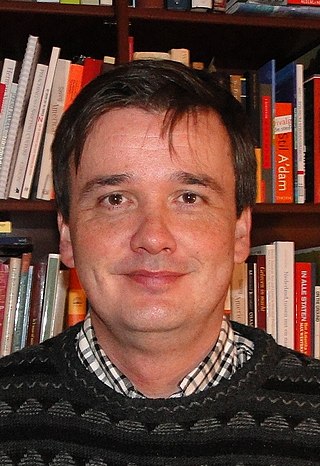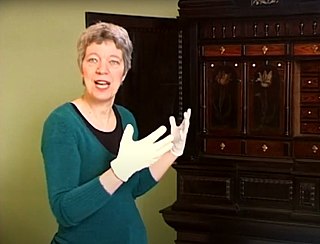Related Research Articles

Zeist is the capital and largest town of the municipality of Zeist. The town is located in the Utrecht province of the Netherlands, east of the city of Utrecht.

De Stijl, also known as Neoplasticism, was a Dutch art movement founded in 1917 in Leiden. De Stijl consisted of artists and architects. In a more narrow sense, the term De Stijl is used to refer to a body of work from 1917 to 1931 founded in the Netherlands. Proponents of De Stijl advocated pure abstraction and universality by a reduction to the essentials of form and colour; they simplified visual compositions to vertical and horizontal, using only black, white and primary colors.

Theo van Doesburg was a Dutch artist, who practiced painting, writing, poetry and architecture. He is best known as the founder and leader of De Stijl. He was married to artist, pianist and choreographer Nelly van Doesburg.

Albert Carel Willink was a Dutch painter who called his style of Magic realism "imaginary realism".

Paul Schnabel is a Dutch politician and sociologist who served on the Social and Economic Council (SER) from 2013 to 2015 and in the Senate on behalf of Democrats 66 (D66) from 2015 until 2019.
Robert van 't Hoff, born Robbert van 't Hoff, was a Dutch architect and furniture designer. His Villa Henny, designed in 1914, was one of the earliest modernist houses and one of the first to be built out of reinforced concrete. From 1917 he was an influential member of the De Stijl movement.
Pieter (Piet) Rietveld was a Dutch economist and Professor in Transport Economics at the Vrije Universiteit, Amsterdam, and a fellow at the Tinbergen Institute. He was among the top researchers in economic geography according to IDEAS/RePEc.

James Carleton Kennedy is an American historian. He is the son of E.W. (Bill) and Nella Kennedy. The elder Dr. Kennedy was for years an eminent professor of religion at Northwestern College (Iowa).

Pieter Frans Christiaan Koch, better known as Pyke Koch, was a Dutch artist who painted in a magic realist manner.
The Canon of the Netherlands is a list of fifty topics that aims to provide a chronological summary of Dutch history to be taught in primary schools and the first two years of secondary school in the Netherlands. The fifty topics are divided into fourteen sections.

Cornelis "Cees" Vervoorn is a retired swimmer from the Netherlands. He competed at the 1976, 1980 and 1984 Summer Olympics in seven events; in 1980, he finished fourth, sixth and seventh in the 100 m and 200 m butterfly and 4 × 100 m medley relay, respectively. In the 100 m butterfly final, he clocked 55.25, missing the bronze medal by 0.12 s. In the semifinal he swam 55.02, qualifying first for the final.

Johannes Jacobus (Jan) van der Vaart was an influential Dutch ceramicist from the 20th century, known as founder of the abstract-geometric ceramics in the Netherlands.

Henricus Petrus Cornelis (Kees) Verschuren is a Dutch sculptor, painter and former lecturer at the Willem de Kooning Academie in Rotterdam, known for his monumentalist sculptures in public places in the Netherlands.
Daniël (Daan) van Golden was a Dutch artist, who has been active as a painter, photographer, collagist, installation artist, wall painter and graphic artist. He is known for his meticulous paintings of motives and details of everyday life and every day images.

Gerhardus "Gert" Hekma was a Dutch anthropologist and sociologist, known for his research and publications, and public statements about (homo)sexuality. He taught gay and lesbian studies at the Faculty of Social and Behavioral Sciences of the University of Amsterdam from 1984 to 2017.

Margaretha Wilhelmina Francina (Mienke) Simon Thomas is a Dutch art historian, curator and author, working as a senior curator at Museum Boijmans Van Beuningen in Rotterdam. She is known for her works on the development of Dutch applied art and design.

Museum MORE is a Dutch museum in Gorssel, Netherlands. Museum MORE is dedicated to Dutch Neorealism (art). It is located in the former town hall of Gorssel, which was expanded for that purpose with seven exhibition spaces. The extension was designed by Dutch architect Hans van Heeswijk. Less than a year after the opening of the public on 2 June 2015, the museum was able to welcome its 100.000th visitor A second branch of Museum MORE, in Ruurlo Castle in the municipality of Gelderland Berkelland, was opened on June 23, 2017, by Pieter van Vollenhoven. In this castle one can find the collection Carel Willink / Fong Leng.
Adriaan Hendrik Stouthamer was a Dutch microbiologist. He was a professor at the Vrije Universiteit Amsterdam from the 1960s to 1996.

Horst Lademacher is a German historian specializing in the history of the Netherlands. He was a professor of modern history at the Vrije Universiteit Amsterdam, University of Kassel and the University of Münster. At the latter institute he was also director of the Zentrum für Niederlande-Studien from 1990 to 2000.
Ferdinand Jacobus van Ingen was a Dutch scholar of Germanistics. He was a professor of German literature at the Vrije Universiteit Amsterdam between 1972 and 1998.
References
- 1 2 "Carel Blotkamp". Yellow-Fellow.org. Retrieved 18 December 2016.
- 1 2 3 4 5 6 Marcel Gieling (15 May 2014). "Carel Blotkamp, expositie in een koeienstal". DUIC. Retrieved 18 December 2016.
- 1 2 3 4 Mayken Jonkman (1 June 2007). "Carel Blotkamp: drie maanden emeritaat". Vereniging van Nederlandse Kunsthistorici. Archived from the original on 12 November 2016. Retrieved 18 December 2016.
- ↑ Sandra Kooke (3 April 2006). "Carel Blotkamp / 'Je ziet een echte persoonlijkheid'". Trouw . Retrieved 18 December 2016.
- ↑ "Album Promotorum - Carel Blotkamp". Utrecht University. Archived from the original on 15 March 2018. Retrieved 18 December 2016.
- 1 2 Rutger Pontzen (29 May 2007). "Altijd vechten tegen vooroordelen". de Volkskrant . Retrieved 18 December 2016.
- ↑ "Carel Blotkamp". Bouwfonds Kunstcollectie. Retrieved 18 December 2016.
- ↑ "Carel Blotkamp". Royal Netherlands Academy of Arts and Sciences. Archived from the original on 18 December 2016.